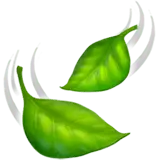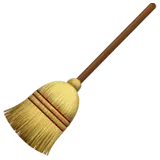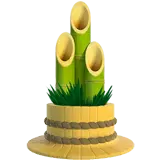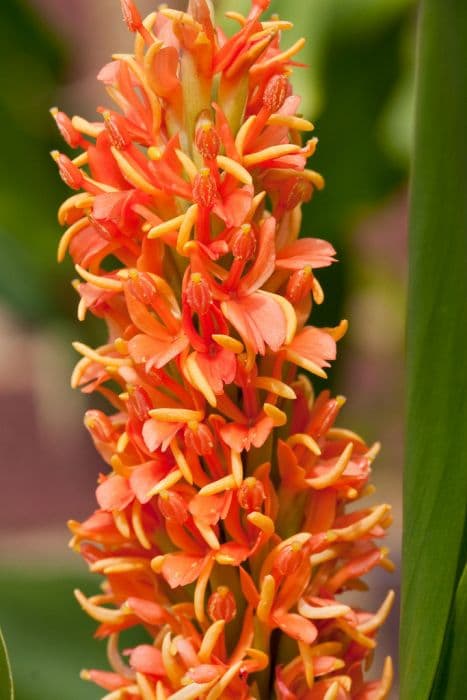Cautleya Spicata Roscoea cautleyoides 'Pennine Purple'

ABOUT
Roscoea cautleyoides 'Pennine Purple', commonly known as ginger lily or Himalayan ginger, is a perennial plant with a bold and striking appearance. It features lush, lance-shaped leaves that are arranged in a spiral fashion along the stem. The foliage provides a dense, green backdrop that accentuates the plant's standout feature: its blooms. The flowers are a deep, velvety purple, characterized by a tubular shape that flares out into a distinctive labellum (lip) at the end, often showcasing a paler or yellow throat. These blooms are borne on short stems that arise directly from the leaf axils. The intricate detailing of the flowers, with their exotic and tropical vibe, can add a dramatic flair to any garden setting. The plant typically shows a clump-forming habit which gives it a full, bushy appearance. It has a robust and fleshy root system that supports its growth. As the plant matures, the foliage and flowers provide a lush, ornamental display, especially valued for the late-season color they bring when many other plants are finishing their bloom cycle. Overall, Roscoea cautleyoides 'Pennine Purple' can be recognized for its eye-catching purple flowers and substantial green foliage that provide visual interest in a garden composition.
About this plant
 Names
NamesSynonyms
Pennine Purple Roscoea, Purple Roscoea, Purple Ginger.family
Common names
Roscoea cautleyoides 'Pennine Purple'.
 Toxicity
ToxicityTo humans
There is limited specific information available about the toxicity of Roscoea cautleyoides, commonly known as Roscoea, to humans. In general, it does not appear to be widely recognized as a poisonous plant. However, as with any plant that is not typically used for food, it is always wise to exercise caution. If Roscoea were poisonous and ingested, symptoms could potentially include gastrointestinal distress such as nausea, vomiting, and diarrhea, though there are no specific reports of this occurring. To be safe, avoid ingesting any part of this plant, and consult a medical professional if ingestion occurs and any adverse reaction is experienced.
To pets
Roscoea cautleyoides, commonly known as Roscoea, does not have a well-documented history of toxicity to pets. There are no specific reports of pets being poisoned by ingesting this plant. However, it is generally advised to prevent pets from eating plants that are not known to be safe. If Roscoea were toxic to pets, symptoms could theoretically include gastrointestinal upset, vomiting, or diarrhea. If a pet ingests any part of this plant and shows any signs of distress, it is important to contact a veterinarian as a precautionary measure.
 Characteristics
CharacteristicsLife cycle
Perennials
Foliage type
Deciduous
Color of leaves
Green
Flower color
Purple
Height
1 feet (30 cm)
Spread
0.5 feet (15 cm)
Plant type
Herb
Hardiness zones
6
Native area
Himalayas
Benefits
 General Benefits
General Benefits- Attractive Flowers: Adds visual interest with its striking purple blooms that emerge in late summer.
- Compact Size: Ideal for smaller gardens or spaces with its tidy and manageable growth habit.
- Drought Tolerance: Once established, it can withstand periods of drought, making it suitable for water-wise gardens.
- Low Maintenance: Requires minimal care beyond the initial planting and occasional watering, making it suitable for busy gardeners.
- Pollinator Friendly: Attracts bees and other beneficial insects, which are essential for pollination in the garden ecosystem.
- Shade Tolerance: Thrives in partial shade conditions where other plants might struggle to grow.
- Herbaceous Perennial: Dies back in winter and returns each spring, offering a reliable display without replanting annually.
- Ornamental Foliage: Features lush green leaves that provide a backdrop for the flowers and add texture to the garden.
- Cold Hardy: Can withstand cold temperatures, which means it can be grown in a variety of climates.
- Non-Invasive: Unlike some garden plants, it does not aggressively spread, making it a good choice for controlled plantings.
 Medical Properties
Medical PropertiesThis plant is not used for medical purposes.
 Air-purifying Qualities
Air-purifying QualitiesThis plant is not specifically known for air purifying qualities.
 Other Uses
Other Uses- Roscoea cautleyoides 'Pennine Purple', commonly known as Roscoea, can be used in floral arrangements for its striking purple flowers that add an exotic touch.
- The robust leaves of the Roscoea can be used as a natural backing in pressed flower art, providing a sturdy and attractive greenery.
- The plant can be grown in containers and pots for urban balconies or patios, offering a splash of color in compact spaces.
- Roscoea's intriguing flower shape makes it a candidate for botanical illustration, and can be used to teach plant structure in art classes.
- The rhizomes of the plant could potentially be used in perfume industry as a source of fragrance upon extraction and processing.
- In colder regions, the Roscoea can be grown in greenhouses as part of a collection of Himalayan plants for educational purposes.
- The plant can be used as a living gift that symbolizes rarity and beauty due to its less common occurrence in gardens.
- Roscoea can serve as an engaging subject for macro photography, allowing photographers to capture the detailed patterns of its flowers.
- The plant may be used in ecological gardens designed to attract pollinators like bees and butterflies due to its nectar-rich flowers.
- Gardeners can plant Roscoea as part of a themed garden focusing on plants from the Himalayan region, where it is originally found.
Interesting Facts
 Feng Shui
Feng ShuiThe Roscoea is not used in Feng Shui practice.
 Zodiac Sign Compitability
Zodiac Sign CompitabilityThe Roscoea is not used in astrology practice.
 Plant Symbolism
Plant Symbolism- Adaptability – Roscoea cautleyoides 'Pennine Purple', commonly known as Hardy Ginger, often symbolizes adaptability due to its ability to grow in a variety of climates and soil types, adapting well to differing garden conditions.
- Unique Beauty – The rich purple flowers of Hardy Ginger stand out in the garden, representing the idea of unique and distinct beauty that captures attention in a subtle yet powerful way.
- Mystery – The exotic appearance of the flower, uncommon to many regions, can symbolize mystery or the allure of the unknown.
- Resilience – Hardy Ginger is robust and can withstand cold temperatures, making it a symbol of resilience and the ability to endure challenging conditions.
 Water
WaterHardy ginger requires consistent moisture during its growing season in the spring and summer. Water the plant deeply once a week, providing about 1 gallon per plant to ensure the soil is moist but not waterlogged. During hot, dry spells, you may need to water twice a week. Cut back on watering as the plant goes dormant in the fall, and during the winter, keep the soil barely moist, watering only every few weeks to prevent the rhizomes from drying out completely.
 Light
LightHardy ginger thrives in partial shade where it receives dappled sunlight. It should be shielded from intense afternoon sun to prevent leaf scorch. The ideal spot would be an area that gets bright, indirect light for most of the day, perhaps under the canopy of a deciduous tree or on the north or east side of a building.
 Temperature
TemperatureHardy ginger prefers a temperate climate and can survive in temperatures ranging from 10°F to 85°F, but it thrives best when the temperature is between 60°F and 75°F. It is cold-hardy and can withstand light frosts, however, prolonged exposure to temperatures below freezing can be harmful to the plant.
 Pruning
PruningHardy ginger does not require extensive pruning. However, to encourage healthier growth and a neater appearance, remove spent flower stalks and trim back any yellowing leaves. The best time to prune is in late fall or early winter after the plant has finished flowering and as it begins to go dormant.
 Cleaning
CleaningAs needed
 Soil
SoilThe Ginger family member Roscoea cautleyoides 'Pennine Purple' thrives in a rich, well-drained soil mix with a slightly acidic to neutral pH range of 6.5 to 7.2. Incorporating organic matter like compost or leaf mold and adequate perlite or grit for improved drainage is ideal for this plant.
 Repotting
RepottingRoscoea cautleyoides 'Pennine Purple', commonly known as Hardy Ginger, should generally be repotted every 2-3 years or when it outgrows its current pot. Repotting is best done in the spring before new growth begins.
 Humidity & Misting
Humidity & MistingHardy Ginger prefers moderate humidity levels, consistent with typical household environments. While the exact humidity range isn't critical, a level of 40-60% is usually suitable for this plant's growth.
 Suitable locations
Suitable locationsIndoor
Place Hardy Ginger in bright, indirect light with moderate humidity.
Outdoor
Plant Hardy Ginger in partial shade, with moist, well-drained soil.
Hardiness zone
6-9 USDA
 Life cycle
Life cycleRoscoea cautleyoides 'Pennine Purple', commonly known as the Pennine Purple Roscoea, begins its life cycle as a seed, which after sowing, germinates in moist, well-drained soil during spring. Seedlings develop into juvenile plants which form a rosette of lance-shaped leaves and depend on sufficient water and light for growth. As the plant matures, typically in the second or third year, it produces elongated stems and distinctive purplish flowers during the summer months. Following the flowering stage, the plants set seeds that are dispersed, potentially generating new individuals. In the autumn, the above-ground foliage dies back, and the plant goes dormant, surviving the winter as a tuberous rhizome underground. With the return of warmer temperatures in spring, the cycle starts anew as new shoots emerge from the rhizome, repeating the annual growth cycle.
 Propogation
PropogationPropogation time
Spring to Summer
Propogation: The Roscoea cautleyoides 'Pennine Purple', commonly known as Himalayan ginger, is generally propagated by division. The ideal time for this propagation method is in the spring, just as the plant is emerging from dormancy. To propagate Himalayan ginger through division, carefully unearth the plant and identify natural divisions within the clump. Using a clean, sharp tool, separate a section of the rhizome that includes both roots and shoots. Replant the division at a similar depth to which it was previously growing, ensuring the area is well-draining and the soil is fertile. Water well to settle the soil around the roots and keep the newly planted division consistently moist but not waterlogged, allowing it to establish in its new location.









